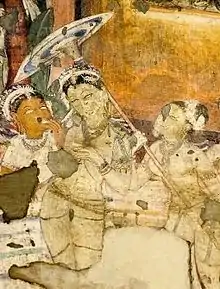Antariya
An antariya (antarīya) is a lower body garment from ancient India. It is a long white or coloured strip of cotton passed through the legs, tucked at the back and covering the legs loosely, then flowing into long pleats at front of the legs.[1][2][3][4]
History
Antriya is an ancient garment mentioned in the Ramayana and Mahabharata.[5] Hindu deities can be seen wearing Uttariya and Antariya in sculpture in the Indian subcontinent,[6] especially in hindu templess and in images in desi calendars.
As mentioned in Buddhist Pali literature during the 6th century BC, Sari śāṭikā (Sanskrit: शाटिका) is an evolved form of Antriya, which was one of three-piece attire worn by women during the ancient period.[1][2][3][7][8][9]
Terminology
The Sanskrit word for Antriya is Antarīya.[10] Lower garment of the ladies of the period are variously referred to as ambara , amsuka , antariya , nivasana , paridhana , vasana , vastram , vasas and sauli in the texts.[11]
Use
Antariya was usually made of fine cotton or silk. It was usually used in combination with the uttariya. The dhoti , lungi are also derived forms of Antriya.
Gallery
 Women in choli (blouse) and antariya c. 320 CE, Gupta Empire
Women in choli (blouse) and antariya c. 320 CE, Gupta Empire Relief depicting men in antariya and uttariya, 1st century CE
Relief depicting men in antariya and uttariya, 1st century CE
References
- Nair, Rukmini Bhaya; deSouza, Peter Ronald (2020-02-20). Keywords for India: A Conceptual Lexicon for the 21st Century. Bloomsbury Publishing. ISBN 978-1-350-03925-4.
- Mehta, Tarla (1995). Sanskrit Play Production in Ancient India. Motilal Banarsidass Publ. ISBN 978-81-208-1057-0.
- Ayyar, Sulochana (1987). Costumes and Ornaments as Depicted in the Sculptures of Gwalior Museum. Mittal Publications. p. 62. ISBN 978-81-7099-002-4.
- Shastri, Ajay Mitra; Varāhamihira (1996). Ancient Indian Heritage, Varahamihira's India: Historical geography, religion, and society. Aryan Books International. p. 224. ISBN 978-81-7305-081-7.
- McLain, Karline (2009). India's Immortal Comic Books: Gods, Kings, and Other Heroes. Indiana University Press. p. 72. ISBN 978-0-253-22052-3.
- Ancient India. Director General of Archaeology in India. 1950. p. 37.
- Prasad Mohapatra, Ramesh (1992). Fashion Styles of Ancient India: A Study of Kalinga from Earliest Times to Sixteenth Century Ad. B.R. Publishing Corporation. p. 35. ISBN 9788170187233.
- Prachya Pratibha, 1978 "Prachya Pratibha, Volume 6", p. 121
- Agam Kala Prakashan, 1991 "Costume, coiffure, and ornaments in the temple sculpture of northern Andhra", p. 118
- www.wisdomlib.org (2018-05-06). "Antariya, Antarīya: 7 definitions". www.wisdomlib.org. Retrieved 2020-12-09.
- Mohapatra, Ramesh Prasad (1992). Fashion Styles of Ancient India: (a Study of Kalinga from Earliest Times to Sixteenth Century A.D.). B.R. Publishing Corporation. p. 26. ISBN 978-81-7018-723-3.
